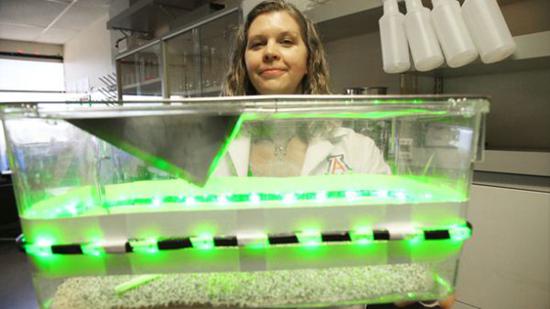New research from the United States, green light source can reduce chronic pain
Mar 09,2017
The stress of modern people is high, leading to chronic pain, many people may have to rely on painkillers, but the latest research from the University of Arizona found that exposure to green LED light source will help relieve pain in the future for patients with chronic pain. It will be a great gospel.

Experimental special contact lenses allow only green light to pass through. (Photo source: Bob Demers/ UANews)
University of Arizona, Dr. Mohab Ibrahim, discovered unexpectedly that sitting under a green tree with a headache seems to have an analgesic effect. Out of curiosity, he decided to do a simple experiment to test whether the green light can really relieve chronic pain.
The team led by Dr. Mohab Ibrahim conducted three groups of experimental white rats with neuropathic pain. They placed the first group of mice in a transparent plastic container with green LED light strips and kept on for eight hours each day for five days. The second group of mice was placed in a general indoor light environment, but wearing special contact lenses allowed only green light to pass through the mouse's eyes. As for the third group of white mice, they wear opaque contact lenses and cannot see any color of light.

Experimental special contact lenses allow only green light to pass through. (Photo source: Bob Demers/ UANews)
Experimental results show that the former two groups can tolerate stronger temperature and tactile stimuli than the control group of white mice, and no side effects were found in the process. And after the last light, the mouse continued to maintain this effect for the next four days.
Initially, scientists determined that this may be because green light has increased the level of "endogenous opioid" in rats. This substance protects against pain and relieves nervous system inflammatory reactions. The results of the study have been published in the February issue of Pain.
At present, researchers are conducting 10-week human clinical trials on 10 patients with fibromyalgia. The preliminary results are encouraging. Because of the significant analgesic effect, even two patients refused to return the green LED light source for this experiment to the research team.
Although the study is still in its infancy, Dr. Mohab Ibrahim said that this type of lamp created by a green LED light source has considerable potential to mitigate specific chronic pain. And this therapy is safe, effective and affordable. He hopes to launch a green LED light therapy in the future, or collaborate with other methods, to help many suffer from pain.
- Latest news
34 genius hacks for LED strip lights
Apr 02,2021LED Strip Lights: How Are They Made?
Nov 30,2020LIVING ROOM LIGHTING IDEAS
Oct 30,2020LED LIGHTING VS. FLUORESCENT LIGHTING – THE FACTS
Sep 29,2020HOW TO PLAN YOUR KITCHEN LIGHTING
Aug 27,2020LIGHTING DESIGN: 5 TIPS FOR INTERIOR DESIGNERS
Jul 31,2020HOW TO USE INTEGRATED LINEAR LIGHTING
Jun 02,2020
